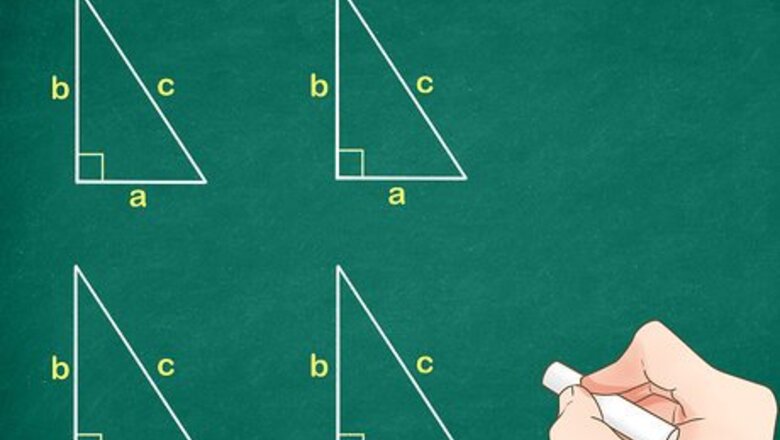
views
X
Research source
The theorem states that the sum of the squares of the two sides of a right triangle equals the square of the hypotenuse: a2 + b2 = c2.[2]
X
Research source
The theorem can be proved in many different ways involving the use of squares, triangles, and geometric concepts. Two common proofs are presented here.
Using Squares

Draw four congruent right triangles. Congruent triangles are ones that have three identical sides. Designate the legs of length a and b and hypotenuse of length c. The Pythagorean Theorem states that the sum of squares of the two legs of a right triangle is equal to the square of the hypotenuse, so we need to prove a + b = c. Remember, the Pythagorean Theorem only applies to right triangles.
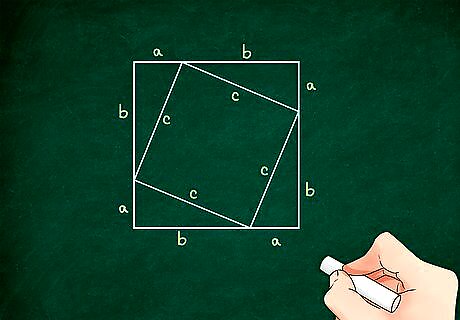
Arrange the triangles so that they form a square with sides a+b. With the triangles placed in this way, they will form a smaller square (in green) inside the larger square with four equal sides of length c, the hypotenuse of each triangle. The larger square has sides of length a+b. You can rotate (turn) the entire arrangement by 90 degrees and it will be exactly the same. You can repeat this as many times as you like. This is only possible because the four angles at the corners are equal.
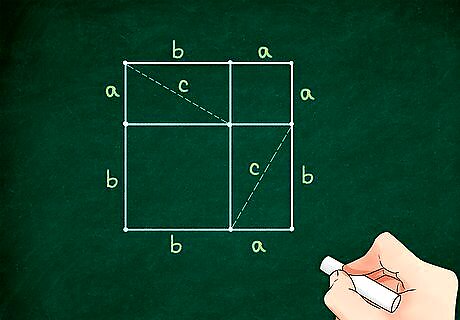
Rearrange the same four triangles such that they form two equal rectangles inside a larger square. Again, the larger square will have sides of length a+b, but in this configuration there are two rectangles (in grey) of equal size and two smaller squares within the larger square. The larger of the smaller squares (in red) has sides of length a, while the smaller square (in blue) has sides of length b. The hypotenuse of the original triangles is now the diagonal of the two rectangles formed by the triangles. EXPERT TIP Joseph Meyer Joseph Meyer Math Teacher Joseph Meyer is a High School Math Teacher based in Pittsburgh, Pennsylvania. He is an educator at City Charter High School, where he has been teaching for over 7 years. Joseph is also the founder of Sandbox Math, an online learning community dedicated to helping students succeed in Algebra. His site is set apart by its focus on fostering genuine comprehension through step-by-step understanding (instead of just getting the correct final answer), enabling learners to identify and overcome misunderstandings and confidently take on any test they face. He received his MA in Physics from Case Western Reserve University and his BA in Physics from Baldwin Wallace University. Joseph Meyer Joseph Meyer Math Teacher Use this visual trick to understand the Pythagorean Theorem. Imagine a right triangle with squares constructed on each leg and the hypotenuse. by rearranging the smaller squares within the larger square, the areas of the smaller squares (a² and b²) will add up visually to the area of the larger square (c²).
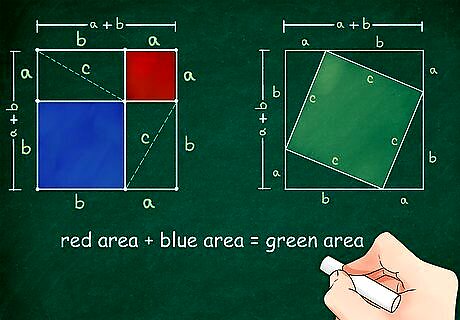
Recognize that the area not formed by the triangles is equal in both arrangements. In both cases, you have a large square with sides of a+b. Given this, the areas of both of the large squares are equal. Looking at both arrangements, you can see that the total area of the green square must equal the areas of the red and blue squares added together in the second arrangement. In both arrangements we partially covered the surface with exactly the same amount, four grey triangles that didn't overlap. This means that also the area left out by the triangles must be equal in both arrangements. Therefore, the area of the blue and the red square taken together must be equal to the area of the green square.
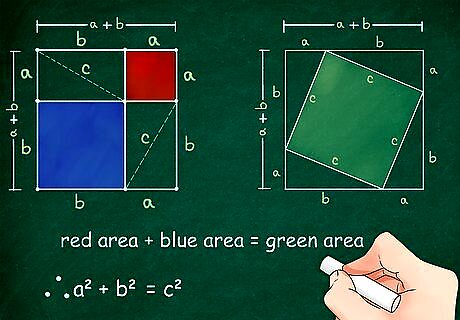
Set the areas of each arrangement equal to each other. The blue area is a, the red area, b and the green area, c. The red and blue squares must be added together to equal the area of the green square; therefore, blue area + red area = green area: a + b = c. This finishes the proof.
Using Trapezoids
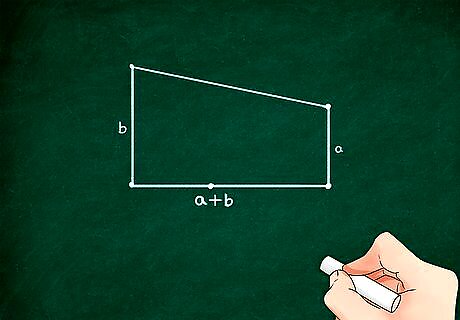
Draw a trapezoid with base a+b and sides a and b. Sketch a trapezoid with the following measurements: left side of height b, right side of height a, and base of length a+b. Simply connect the tops of the left and right sides to complete the trapezoid.
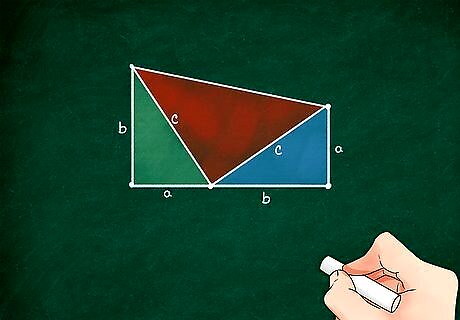
Divide the trapezoid into three right triangles, two of which are congruent. Divide the base of the triangle into lengths a and b so that two right triangles of lengths a, b, and c is formed. The third triangle will have two sides of length c and a hypotenuse of length d. The two smaller triangles are congruent (identical).
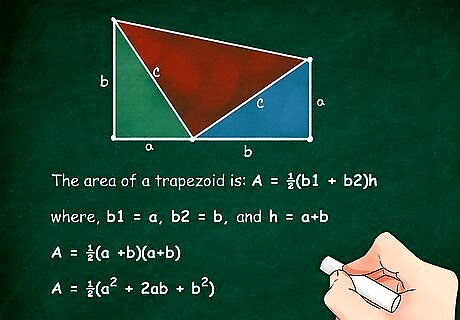
Calculate the area of the trapezoid using the area formula. The area of a trapezoid is: A = ½(b1 + b2)h where b1 is one straight side of the trapezoid, b2 is the other straight side of the trapezoid, and h is the height of the trapezoid. For this trapezoid: b1 is a, b2 is b, and h is a+b. The area of this trapezoid is A = ½(a +b)(a+b) . Expanding the binomial yields: A = ½(a + 2ab + b).
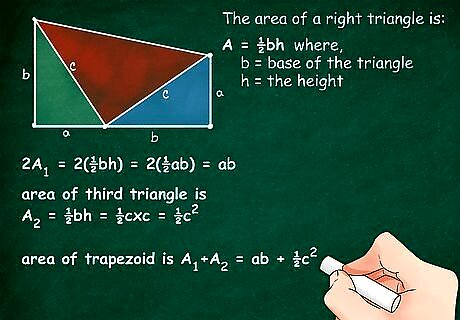
Find the area by summing the areas of the three triangles. The area of a right triangle is: A = ½bh where b is the base of the triangle and h is the height. This trapezoid has been broken into three different triangles; therefore, the areas need to be added together. First, find the area of each one and then add all three together. Because two of the triangles are identical, you can simply multiply the area of the first triangle by two: 2A1 = 2(½bh) = 2(½ab) = ab. The area of the third triangle is A2 = ½bh = ½c*c = ½c. The total area of the trapezoid is A1 + A2 = ab + ½c.
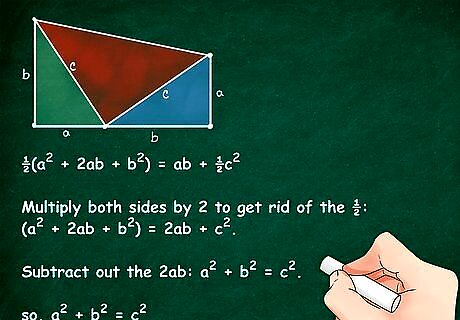
Set the different area calculations equal to each other. Because both of these calculations are equal to the total area of the trapezoid, you can set them equal to each other. Once they’re set equal to each other, you can reduce the equation to its simplest form. ½(a + 2ab + b) = ab + ½c. Multiply both sides by 2 to get rid of the ½: (a + 2ab + b) = 2ab + c. Subtract out the 2ab: a + b = c. You’re left with the proof: a + b = c. EXPERT TIP Joseph Meyer Joseph Meyer Math Teacher Joseph Meyer is a High School Math Teacher based in Pittsburgh, Pennsylvania. He is an educator at City Charter High School, where he has been teaching for over 7 years. Joseph is also the founder of Sandbox Math, an online learning community dedicated to helping students succeed in Algebra. His site is set apart by its focus on fostering genuine comprehension through step-by-step understanding (instead of just getting the correct final answer), enabling learners to identify and overcome misunderstandings and confidently take on any test they face. He received his MA in Physics from Case Western Reserve University and his BA in Physics from Baldwin Wallace University. Joseph Meyer Joseph Meyer Math Teacher Learning different proofs will help you master the Pythagorean Theorem. Discovering the Pythagorean Theorem can be approached through visual or algebraic methods. By exploring the proof from different angles, you can solidify your knowledge and make it easier to remember.
















Comments
0 comment